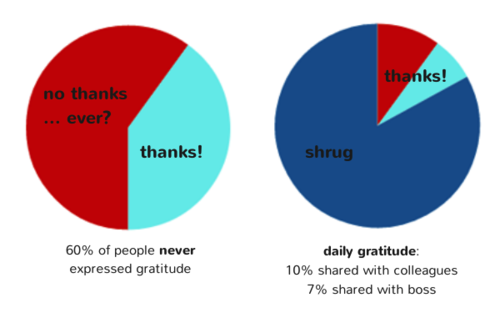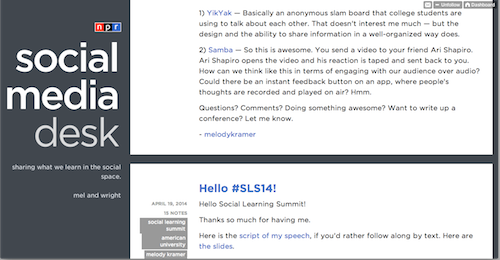When I first joined iDoneThis, I hated our weekly meetings. They were demoralizing and amorphous. We rambled on, drowning in circuitous discussions about product that led nowhere. The meetings became a chore, making us feel like sulky high school students waiting for the bell to ring.
LinkedIn CEO Jeff Weiner noticed a similar bad meeting phenomenon of tending to “devolve into a round robin of complaints.” His unconventional solution was to change up the meeting format by promoting something you wouldn’t expect: gratitude.
Gaining Through Gratitude

The sad fact is that the workplace is the worst place to find gratitude, according to a 2012 survey by the John Templeton Foundation. 60% of people reported that they never expressed gratitude, or “perhaps once a year.” Only 10% of people share their gratitude every day with their colleagues, a mere 7% with their boss.
The implication is depressing: day by day, people’s effort and hard work get taken for granted. How deflating it feels to toil away, unappreciated. How easy it is, then, to stop toiling.
This swath of the unthanked is missing out on one of the easiest, well-proven ways to make you feel better and less stressed. Psychologist Robert Emmons discovered that when people wrote down five things they were grateful for in a weekly journal for ten weeks, they felt 25% happier. (Amazingly, they even spent more time exercising!)
When people took five to ten minutes at the end of their workday to record three personal or work-related things that went well and why, stress levels and physical health complaints — such as neck and back pain, headaches, fatigue and difficulty focusing — decreased by 15%. Researchers concluded that reflecting on positive events is an overlooked resource, proposing:
“a manager modifying the 3 good things intervention, starting weekly staff meetings by asking employees to share good events from the past week. Focusing on accomplishments, sharing positive experiences, celebrating success, and expressing gratitude would be a change for most organizations and their employees.”
This is exactly the practice Weiner implemented in his weekly executive meetings at LinkedIn. Before getting down to business, everyone goes around and shares one personal and one professional win. Kicking off a meeting through this positive lens of accomplishment, recognition, and gratitude doesn’t just lower stress but also paves the way for a more productive meeting, with higher energy and lower chances of getting bogged down in the negative and irrelevant.
How Gratitude Motivates
According to Weiner, gratitude is the “highest ROI management tool I know … that is available to everyone, costs essentially nothing, and is a proven driver of workplace productivity.” Gratitude doesn’t just make you feel better, it makes you want to contribute more.
Adam Grant and Francesca Gino found that when people received recognition, they helped others for longer, without even being asked to do so. In one of their studies, the director of annual giving visited a group of fundraisers, who had the usually thankless job of asking alumni for donations, and told them, “I am very grateful for your hard work. We sincerely appreciate your contributions to the university.”
That simple expression of thanks resulted in more than a 50% increase in the number of calls in a single week. Gratitude, Grant and Gino explain, increases our feeling of efficacy and self-worth, which sets us up to continue contributing.

Create Channels for Gratitude to Flow
Most of us recognize that we want to feel valued, that it helps us feel engaged and motivated. The Templeton Foundation numbers confirm this, with up to 80% of people reporting that they’d feel better and work harder if they received more gratitude from their boss, and 88% declaring that sharing their appreciation would make them feel happier and more fulfilled.
How come we yearn for the gratitude of others but so rarely share it ourselves — even when we know it’ll feel good? It comes down to expectations and opportunities. When practicing gratitude out loud at work isn’t common, we don’t know if it’s acceptable behavior. This is why leaders can make a real difference by setting examples and providing opportunities for authentic recognition and appreciation to happen.
“Showing gratitude is frequently about catching people doing something right, but it’s critical for leaders to model that behavior so that their teams show each other gratitude,” explains Rich Paret, director of engineering at Twitter. Communicating gratitude cements the team and patterns of great work. “When unexpected challenges arise, my team quickly jumps into action, unconstrained by their traditional ‘roles.’ Through public recognition of this behavior, we see stronger team communication, camaraderie and repeat behaviors.”
“You should always highlight what your coworkers are up to if they’re doing good work,” agrees Melody Kramer, digital strategist at NPR. She created a daily internal newsletter, circulated among 450 people across NPR (and now publicly available), to do just that, strengthening the organization by passing on information about how people were experimenting with social media and digital and what worked.
The new platform also provides a friendly way for people to share and recognize each others’ wins, especially for people who hesitate to show off work they’re proud of. “I can completely understand that it’s very hard,” Melody comments. “You don’t want to be constantly waving around things that you did because that’s not a personality trait that people necessarily like. But there is value in sharing success stories, and if you have a platform for doing that, then people feel much more comfortable.”
Melody sees her job as thinking about how to make the NPR newsroom more productive and make their jobs more enjoyable, even “when they’re being asked to do 8 million things a day.” Being mentioned and sharing, she found, made people happy, which in turn led to more sharing, building up not just appreciation and morale but knowledge. For a large nonprofit with many people but limited resources, that’s powerful.
3 More Ways to Close the Gratitude Gap
The gratitude gap results in less happiness, less wellness, less connection, less knowledge, and yes, most likely less productivity. Gratitude strengthens all around. Every opportunity for gratitude is also a chance to encourage the kind of behavior, attitude, and work you want to see.
Here are three more tips on how to create those opportunities:
Share your wins.
Share your wins by writing them down in a group list, a common space, or out loud at a meeting. Be specific by thinking through the what, why, and who helped to make them happen. This is a practice that’s an utter waste of time if you phone it in, so take authenticity over frequency, quality over quantity.
Make Your Learning Open-Source.
Wins often arise from what we learn. Making what you do and learn more public, as Melody did at NPR, can promote more sharing and involvement. “It’s like open-sourcing your knowledge,” she describes.
Wistia uses a team done list to open-source good things about their work day. Director of Customer Happiness Jeff Vincent explains that this stimulates productive conversation, collaboration, and inspiration that wouldn’t have happened otherwise.
For example, when his coworker Mercer posted, “Did my first real coding in JS”, Dave reached out to give her props and ask about what she did. Mercer ended up sharing her code so that Dave, also new to JavaScript, got to learn. What does Jeff think of this? “An awesome teaching, sharing moment — this is huge!”
Schedule gratitude opportunities.
Here at iDoneThis, we eventually switched over to a new type of weekly meeting, a show-and-tell. Every Friday, we get on videochat and share something we’re proud of that we worked on in the past week or that we learned. As a distributed team, having this deliberate face-time to reflect on wins and talk positively about work helps us learn from each other, feel like we’re building something together, and boosts our morale.
* * * * *
Gratitude has something of a cheesy reputation, invoked on holidays and in sentimental moods, but I’m not talking about grand gestures or greeting cards. I’m talking about the simple act of giving thanks, sharing your appreciation, recognizing others.
Call it what you will, it’s the understanding that you can’t get very far in this world, in work, in life without the help and support of others. It’s a battle cry against the round robin to nowhere as an all-too-common fixture at work — the result of not paying enough attention to people, their dynamics, and not just what they’re doing but how. As Jeff from Wistia says so simply, “Everyone needs support. Everyone needs to know their work matters.”
Liked this post? Subscribe to our free newsletter for more great content on productivity, management, and how to work better!
Image of heart: Judy Merrill-Smith/Flickr

